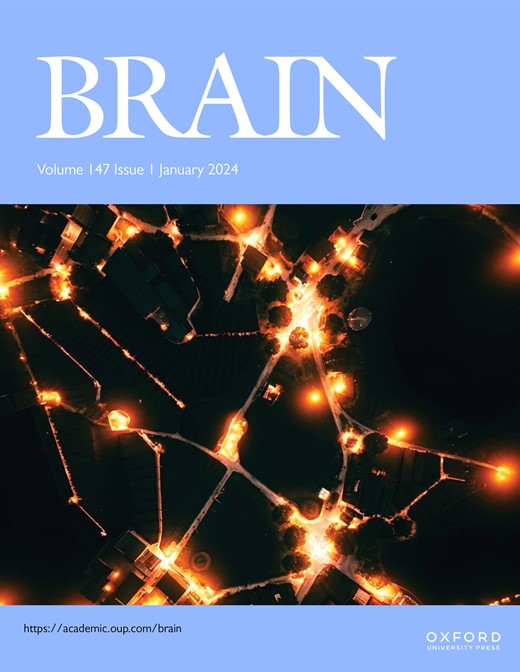Interferon-γ causes myogenic cell dysfunction and senescence in immune myopathies
IF 10.6
1区 医学
Q1 CLINICAL NEUROLOGY
引用次数: 0
Abstract
Idiopathic immune myopathies (IIM) represent a heterogeneous group of diseases, in which muscle lesions result from deregulated immune reactions. Typical histological features include myofibre necrosis, leukocyte infiltration, and aberrant myofibre Major Histocompatibility Complex (MHC) expression. To investigate the link between MHC expression, inflammation, and muscle lesions, muscle biopsies from IIM patients were analysed by transcriptomics. Both, anti-synthetase syndrome (ASS) and inclusion body myositis (IBM) displayed the upregulation of IFNγ and senescence signalling pathways. Notably, IFNγ expression significantly correlated with myofibre atrophy in ASS and IBM muscle biopsies. In addition to MHC-II expression at the myofibre sarcolemma in IBM, we observed a marked overexpression in the muscle stem cells (MuSC) population, suggesting that resident satellite cells respond to IFNγ in this condition. To examine the link between IFNγ and muscle atrophy via MuSCs, we implanted an osmotic pump chronically releasing recombinant mouse IFNγ in wild-type mice subjected to acute muscle injury. Under IFNγ exposure, post-injury muscle repair was associated with significantly reduced muscle weight and myofibre diameter, while promoting interstitial fibrosis and fat deposition. The mechanism of action of the IFNγ-induced myofibre atrophy was further investigated in vitro using cultured human MuSCs. IFNγ stimulation dramatically impaired MuSCs proliferation, fusion, and promoted cell senescence. Isolated myofibres from IFNγ-treated wild-type mice displayed a significant decrease of MyoD expression and cell cycling, suggesting that IFNγ also prevents MuSC activation. In vitro, ruxolitinib, a commercially available JAK1/2 antagonist, blocked IFNγ-induced expression of MHC-II, restored normal MuSC proliferation, and reduced β-Galactosidase activity, a marker of cell senescence. In vivo, oral delivery of ruxolitinib improved myofibre size and biomarkers of muscle atrophy. Our study provides multiple lines of evidence that IFNγ may mediate muscle atrophy in IBM patients. The identified mechanism of action involves JAK1/2 pathways, which impair MuSC function by preventing post-lesion myogenesis and promoting cell senescence. Our data suggest that repurposing JAK1/2 inhibitors may offer a new therapeutic option for treating IBM, a condition known for its resistance to classical immunosuppressant drugs, despite their effectiveness in other IIM.干扰素-γ在免疫肌病中引起肌原性细胞功能障碍和衰老
特发性免疫肌病(IIM)代表了一组异质性疾病,其中肌肉病变是由免疫反应失调引起的。典型的组织学特征包括肌纤维坏死、白细胞浸润和肌纤维主要组织相容性复合体(MHC)表达异常。为了研究MHC表达、炎症和肌肉病变之间的联系,对IIM患者的肌肉活检进行了转录组学分析。抗合成酶综合征(ASS)和包涵体肌炎(IBM)均表现出IFNγ和衰老信号通路的上调。值得注意的是,在ASS和IBM肌肉活检中,IFNγ表达与肌纤维萎缩显著相关。除了IBM肌纤维膜上的MHC-II表达外,我们还观察到肌肉干细胞(MuSC)群体中有明显的过表达,这表明在这种情况下,常驻卫星细胞对IFNγ有反应。为了通过musc研究IFNγ与肌肉萎缩之间的联系,我们在急性肌肉损伤的野生型小鼠中植入了一个慢性释放重组小鼠IFNγ的渗透泵。在IFNγ暴露下,损伤后肌肉修复与肌肉重量和肌纤维直径显著减少相关,同时促进间质纤维化和脂肪沉积。利用体外培养的人musc进一步探讨ifn γ诱导肌纤维萎缩的作用机制。IFNγ刺激可显著损害MuSCs的增殖、融合并促进细胞衰老。IFNγ处理的野生型小鼠的分离肌纤维显示MyoD表达和细胞周期显著减少,表明IFNγ也可以阻止MuSC激活。在体外,ruxolitinib,一种市售的JAK1/2拮抗剂,阻断ifn γ-诱导的MHC-II的表达,恢复正常的MuSC增殖,并降低β-半乳糖苷酶活性,这是细胞衰老的标志。在体内,口服鲁索利替尼可改善肌纤维大小和肌肉萎缩的生物标志物。我们的研究提供了多种证据,证明IFNγ可能介导IBM患者的肌肉萎缩。已确定的作用机制涉及JAK1/2途径,该途径通过阻止损伤后肌肉生成和促进细胞衰老来损害MuSC功能。我们的数据表明,重新利用JAK1/2抑制剂可能为治疗IBM提供一种新的治疗选择,尽管它们在其他IIM中有效,但这种疾病以其对经典免疫抑制药物的耐药性而闻名。
本文章由计算机程序翻译,如有差异,请以英文原文为准。
求助全文
约1分钟内获得全文
求助全文
来源期刊

Brain
医学-临床神经学
CiteScore
20.30
自引率
4.10%
发文量
458
审稿时长
3-6 weeks
期刊介绍:
Brain, a journal focused on clinical neurology and translational neuroscience, has been publishing landmark papers since 1878. The journal aims to expand its scope by including studies that shed light on disease mechanisms and conducting innovative clinical trials for brain disorders. With a wide range of topics covered, the Editorial Board represents the international readership and diverse coverage of the journal. Accepted articles are promptly posted online, typically within a few weeks of acceptance. As of 2022, Brain holds an impressive impact factor of 14.5, according to the Journal Citation Reports.
 求助内容:
求助内容: 应助结果提醒方式:
应助结果提醒方式:


